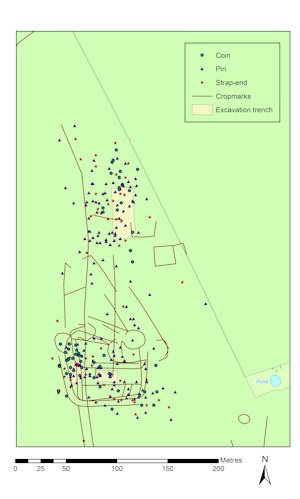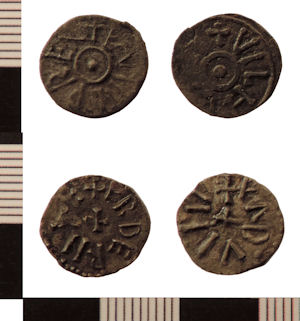

In recent years, and with the aim of better understanding the Anglo-Scandinavian phase, an equivalent amount of detecting has been undertaken in the northern area, along with two further episodes of field-walking in 2010 and 2014. As a result both areas can now be seen to have substantial and similar assemblages of 9th-century non-ferrous dress accessories: each pin and strap-end type is well represented (Figure 12). The numbers of stycas in the northern area has also increased to 18, fewer than in the southern area, although it is now recognised that the number of coin finds there, related to the enclosure, is raised slightly by the presence of a small hoard, comprising at least two silver-alloy coins of Eanred (Figure 13a-b) found stuck together, and quite likely others found close by. The silver issues of Eanred are from early in his reign, probably 820-30, and one such styca from the northern area, together with significant numbers of Anglo-Saxon dress accessories, suggest activity there from early in the 9th century until the arrival of the Vikings. The pottery found in the northern area during the 1995 excavation (Richards 1999a, 58-9), together with the sandstone hones and iron knives, which are indistinguishable from those in the south, support the notion of concurrent activity in the northern and southern areas for much of the 9th century.

During the 1993 excavation, evidence for reorganisation of the Anglian settlement in the first half of the 9th century was identified in the form of reconstruction of the timber buildings on new alignments (Richards 1999a, 34). The evidence detailed above, much of which has emerged since this excavation, suggests the opening up of the new zone of activity to the north around the time of, and perhaps connected to, the reorganisation in the Anglian enclosure, despite the lack of Anglian habitation features in the new area. If this was not an expanded habitation area then other possibilities include an industrial zone, which might explain the large quantities of fuel ash found during excavation; a market or trading area; or the use of the north for rubbish disposal. While it is also possible that these finds were deposited during the subsequent Viking activity (and that was once considered the likely interpretation for the few stycas found in the 1995 excavation of the Anglo-Scandinavian farmstead), that explanation is now felt to be unlikely given the wide range of finds, which include everyday objects.
The 1993 excavation led us to conclude that the Anglian habitation in the south ended in the late 9th century (Richards 1999a, 34-40) and there is now good reason to suppose that, whatever the nature of the activity in the north, this ended at the same time. All excavated Anglian sites in the region, including Burdale, West Heslerton and Wharram Percy, appear to have been abandoned or reorganised at this point (Richards and Roskams 2012; Powlesland 1998; Wrathmell 2012d), and the artefact assemblages from metal-detected sites indicate a similar pattern (Haldenby and Richards in prep.). It seems reasonable to connect this with the arrival of a section of the Viking Great Army and Halfdan’s settlement of Northumbria.
Internet Archaeology is an open access journal based in the Department of Archaeology, University of York. Except where otherwise noted, content from this work may be used under the terms of the Creative Commons Attribution 3.0 (CC BY) Unported licence, which permits unrestricted use, distribution, and reproduction in any medium, provided that attribution to the author(s), the title of the work, the Internet Archaeology journal and the relevant URL/DOI are given.
Terms and Conditions | Legal Statements | Privacy Policy | Cookies Policy | Citing Internet Archaeology
Internet Archaeology content is preserved for the long term with the Archaeology Data Service. Help sustain and support open access publication by donating to our Open Access Archaeology Fund.